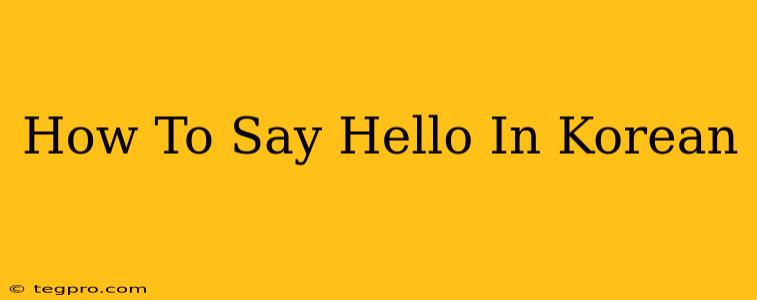Learning a new language can feel daunting, but starting with simple greetings is a great way to build confidence. Korean, with its unique sounds and writing system, might seem intimidating at first, but saying "hello" is easier than you think! This guide will walk you through various ways to greet people in Korean, from formal to informal, and provide helpful tips for pronunciation.
Basic Korean Greetings:
The most common way to say hello in Korean is 안녕하세요 (annyeonghaseyo). This is a polite and versatile greeting suitable for most situations, regardless of the time of day. It's the Korean equivalent of "hello," "good morning," "good afternoon," and "good evening." You can use it with anyone you don't know well, superiors, or elders.
Pronunciation Tips for 안녕하세요 (annyeonghaseyo):
- 안녕 (annyeong): The "an" sounds like the "an" in "ant," while the "nyeong" is a softer sound, almost like a combination of "ny" and "eong."
- 하세요 (haseyo): This part is pronounced with a slight emphasis on the "ha," followed by "seyo."
Beyond 안녕하세요 (annyeonghaseyo):
While 안녕하세요 (annyeonghaseyo) is your go-to greeting, Korean offers other ways to say hello depending on context and your relationship with the person you're addressing:
Informal Greetings:
- 안녕 (annyeong): This is a more casual and informal way to say "hello" or "hi," typically used among close friends, family, and people of similar age. It's like saying "hey" or "hi" in English.
Other Ways to Greet Someone:
- 잘 지냈어요? (jal jinaesseoyo?): This translates to "How have you been?" and is a great way to show you care and engage in a conversation beyond a simple hello. It's a polite way to ask, suitable for most situations.
- 오랜만이에요! (oraenmanieyo!): This means "Long time no see!" and is perfect for reconnecting with someone you haven't seen in a while.
Mastering Korean Greetings:
The key to mastering Korean greetings lies in practice and understanding the nuances of formality. Here are some additional tips:
- Listen to native speakers: Immerse yourself in the language by listening to Korean music, watching Korean dramas, or using language learning apps. This will help you familiarize yourself with the pronunciation and intonation.
- Practice speaking: Don't be afraid to make mistakes! The more you practice, the more confident you'll become. Find a language partner or tutor for extra help.
- Pay attention to context: Observe how Koreans greet each other in different situations. This will help you understand the appropriate level of formality for various contexts.
Conclusion:
Learning how to say "hello" in Korean is just the beginning of a rewarding journey. By mastering these basic greetings, you'll open doors to deeper cultural understanding and build connections with Korean speakers. So, go ahead and try saying 안녕하세요 (annyeonghaseyo) – you might be surprised how easy it is! Remember, consistent effort is key to fluency. Good luck on your language learning adventure!

